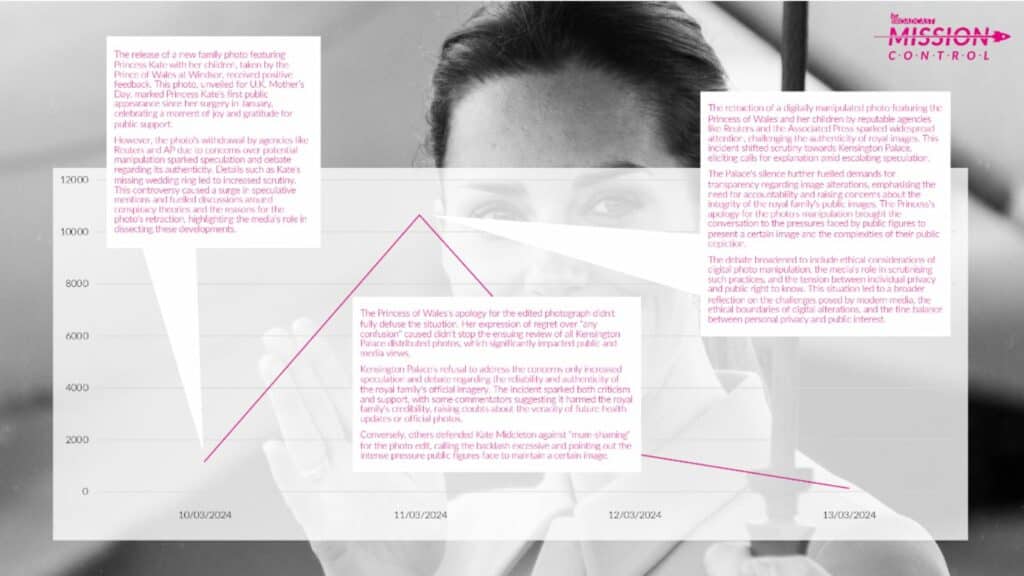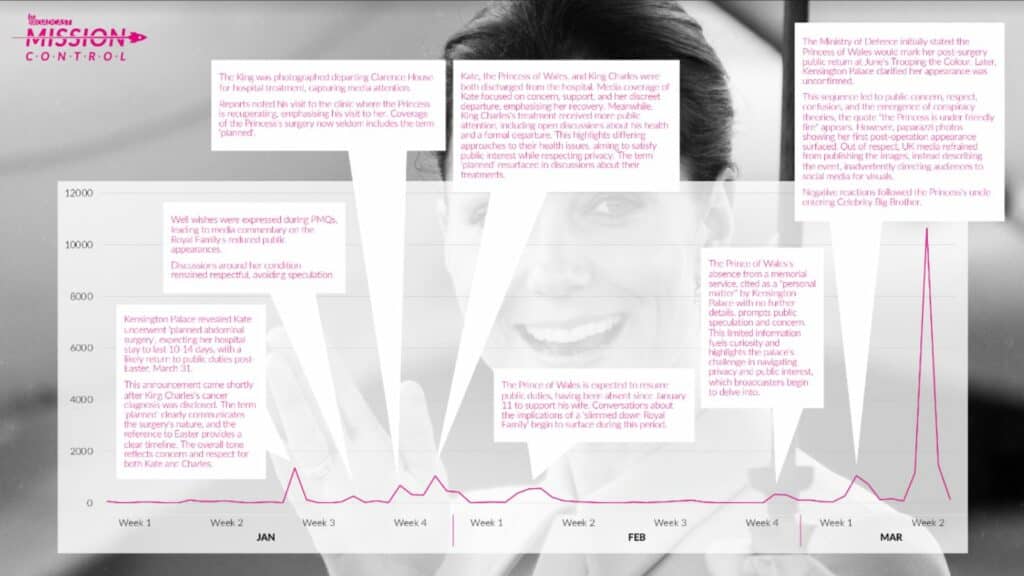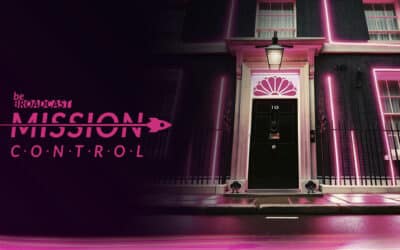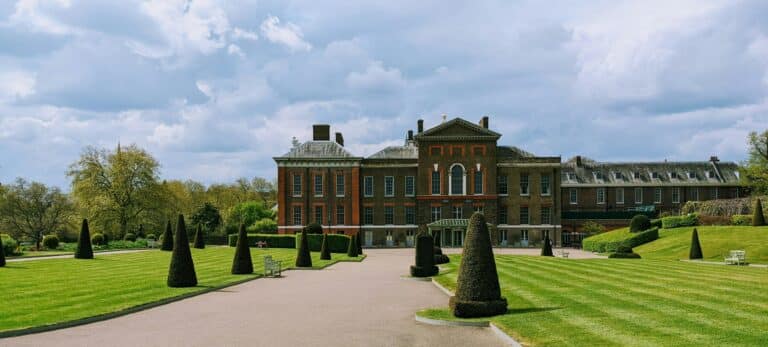The rumour mill has been in overdrive ever since the Princess of Wales, Kate Middleton, stepped away from the public spotlight following “planned” surgery in January.
With intense speculation about her health mounting, Kensington Palace released a seemingly innocent photo of Middleton pictured beaming with her three children to mark Mother’s Day.
But all wasn’t what it seemed. From misplaced patches of clothing to blurry inconsistencies, the authenticity of the photo was soon being scrutinised by the media and wider public.
Major news and picture agencies suddenly issued urgent ‘kill notices’ on the image, advising they believed it had been ‘manipulated’.
It soon sent the conspiracy theories spiralling and prompted an apology from Kate Middleton, who issued a statement that said as “many amateur photographers” she “occasionally” experimented with editing. Phil Chetwynd, global news director at Agence France-Presse (AFP), recently said Kensington Palace is no longer a “trusted source” following the photo furore.
Like many amateur photographers, I do occasionally experiment with editing. I wanted to express my apologies for any confusion the family photograph we shared yesterday caused. I hope everyone celebrating had a very happy Mother’s Day. C
— The Prince and Princess of Wales (@KensingtonRoyal) March 11, 2024
It’s only fuelled speculation about what’s really happening with the Princess and how Kensington Palace’s PR team have handled the situation, but it goes beyond Kate Middleton’s questionable editing skills.
“It raises wider issues about privacy and privilege, the right to know and the right to silence,” explains Peter Davenport, head of crisis communications at brand alignment consultancy Definition.

“In a crisis, there are two principle ways of responding; say nothing even in the face of intense speculation in the hope and expectation that some other issue will soon dominate the headlines (yes, that’s you Tory donor Frank Hester!!!) or give a truthful presentation of facts that cut the ground from under the social media conspiracists.
“That doesn’t mean issuing line-by-line rebuttals of claims or allegations as that just gives the issue oxygen to breathe continuing life into the controversy. Responses should be brief, factual and consistent.”
But how has Kensington Palace handled the ongoing furore over Kate Middleton?
The first misstep was Kensington Palace’s “tight-lipped stance”, explains Josh Wheeler, founder of Be Broadcast. While the King was seen by the public, the Princess “remained out of sight”, which has only fuelled intense speculation on social media.
Be Broadcast has analysed press attention on Kate Middleton with its Mission Control tool, which provides human-led data analysis with PR advice and guidance.


Click the images to enlarge.
The release of the photo “raised issues of trust, especially considering the photo was edited, further straining an already precarious communication strategy,” he explains.
“This situation underscores a need for the Palace to critically reassess its communication strategy, particularly in managing public relations and maintaining trust. The fleeting support from the ‘Don’t Bully Kate’ sentiment signals an urgent need for recalibration. The Palace must clarify decision-making processes, establish clear protocols for announcements, and enhance attention to detail to navigate the complexities of public perception and media engagement effectively.
“Another crisis comms rule – apologise, acknowledge, act. We’ve had the first two from the Princess herself.”

“Kensington Palace got spooked…”
“Kensington Palace could have maintained its stance of refusing to give a running commentary on the Princess’s recuperation beyond its original statement that she would return to Royal duties after Easter”, says Davenport.
“Frustrating for the media but a defensible position – the Princess was entitled to privacy around her medical condition and updates would be given should circumstances change.
“But in a vacuum of information, rumour, gossip and wild theories breed, and Kensington Palace got spooked. The decision to issue the photograph was seen by its PR team as a way of effectively countering the wilder machinations, particularly circulating online, about what was really going on with the Wales’s.
“And what better timing that doing so on Mother’s Day? That would surely tug the nation’s heartstrings? Right? Wrong!
“It backfired in a spectacular way because the Royal advisers tried to have it both ways – saying nothing for months then saying something in such a cack-handed way that only served to add fuel to the rumour mill.”
“Kensington Palace should take a leaf out of the Bucking Palace playbook”
Wheeler says the edited image has implications for all of us.
“Authoritative voices, be they individuals, institutions, or brands, find themselves at a crucial point too. The imperative for authenticity has never been more pronounced – likely what the Princess was aiming for – demanding a commitment to building and maintaining trust.
“The responsibility extends beyond the mere cultivation of a reputable image through PR strategy; it encompasses the active engagement in counteracting the misinformation from external entities, such as scammers, or those ‘conspiracy theorists’ in this story.”
Davenport says the handling of the Princess’s illness in the media is in “stark contrast” to the way the King and his advisers are dealing with his cancer diagnosis and treatment which has generated “sympathy and respect”.
He believes Kensington Palace “should take a leaf out of the Buckingham Palace playbook” and be more transparent about the Princess.
He adds: “Not everyone in the UK is a royalist, so truth in what is said is important in maintaining the support of those that are and countering the anti-monarchist views that aren’t.
“With conflict in Ukraine and Gaza, up-coming elections in the USA and the UK, the spread of misinformation and disinformation as well as the rapid growth of AI generated content and imagery, the mainstream media has to continually strive to be accepted as a source of truth.
“Even if, in this case, the Royal Family is a casualty!”
Kensington Palace’s strategy “simply hasn’t worked”, adds Wheeler. “A crisis comms principle we should all take from this is that if you don’t tell your story, someone else will.”











